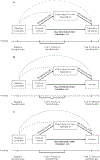Body image, physical activity and psychological health in older female cancer survivors
- PMID: 33967023
- PMCID: PMC8429186
- DOI: 10.1016/j.jgo.2021.04.007
Body image, physical activity and psychological health in older female cancer survivors
Abstract
Objectives: To determine the association of physical activity and body image with psychological health outcomes and whether body image mediates the association of physical activity with psychological health among older female cancer survivors.
Materials and methods: Data from the Women's Health Initiative (WHI) Life and Longevity after Cancer (LILAC) Study were used. Surveys assessed body image (appearance, attractiveness, scars), moderate-strenuous physical activity (min/week), and psychological health (depression, anxiety, distress). A mediation analysis was conducted to estimate the percentage of the total effect of physical activity on psychological health mediated by body image concerns.
Results: Among 4567 female cancer survivors aged 66-98 years, the average time since cancer diagnosis was 9.2 years. Approximately 50% reported no moderate-strenuous physical activity; 15% reported depressive symptoms, 6% reported anxiety, and 5% reported psychological distress; 3% had concerns with appearance, 20% had concerns with attractiveness, and 21% had concerns with scars. When unadjusted for body image concerns, every 30 min/week increase in physical activity was associated with lower risk of depressive symptoms (RR = 0.93, 95%CI: 0.90-0.96), anxiety (RR = 0.92, 95%CI: 0.87-0.97), and distress (RR = 0.92, 95%CI: 0.87-0.98). Body image concerns with appearance mediated 7%, 8.8%, and 14.5% of the association between physical activity and depressive symptoms, anxiety, and distress, respectively.
Conclusion: Older female cancer survivors reported body image concerns, which were associated with both physical activity and psychological health. Our findings suggest that interventions designed to address body image concerns in older female cancer survivors could serve to improve the benefit of physical activity on psychological health.
Keywords: Body image concerns; Cancer survivorship; Mediation effect; Physical activity; Psychological health.
Copyright © 2021 Elsevier Ltd. All rights reserved.
Conflict of interest statement
Declaration of Competing Interest Electra Paskett would like to disclose that she has grant funding from the Merck Foundation and Pfizer. All other authors report there are no conflicts of interest.
Figures

Similar articles
-
Body image as a mediator between bowel dysfunction symptoms and psychological outcomes among patients with colorectal cancer.Support Care Cancer. 2025 Feb 28;33(3):237. doi: 10.1007/s00520-025-09299-8. Support Care Cancer. 2025. PMID: 40019604
-
Medical tattooing as a complementary cosmetic intervention to reduce body-image distress and mental health symptoms in U.S. breast cancer survivors.Support Care Cancer. 2024 Aug 21;32(9):600. doi: 10.1007/s00520-024-08809-4. Support Care Cancer. 2024. PMID: 39167227
-
Association of psychological distress with arm morbidity symptoms in breast cancer survivors: outcomes from the use of PHQ-9 and GAD-7 questionnaires.Breast Cancer. 2023 Sep;30(5):810-819. doi: 10.1007/s12282-023-01475-0. Epub 2023 Jun 12. Breast Cancer. 2023. PMID: 37306933
-
Body image in older breast cancer survivors: A systematic review.Psychooncology. 2020 May;29(5):823-832. doi: 10.1002/pon.5359. Epub 2020 Feb 20. Psychooncology. 2020. PMID: 32048373
-
Telephone interventions for symptom management in adults with cancer.Cochrane Database Syst Rev. 2020 Jun 2;6(6):CD007568. doi: 10.1002/14651858.CD007568.pub2. Cochrane Database Syst Rev. 2020. PMID: 32483832 Free PMC article.
Cited by
-
We will be different forever: A qualitative study of changes of body image in women with breast cancer.BMC Public Health. 2024 Sep 16;24(1):2517. doi: 10.1186/s12889-024-20017-7. BMC Public Health. 2024. PMID: 39285297 Free PMC article.
-
State of the science of sexual health among older cancer survivors: an integrative review.J Cancer Surviv. 2025 Aug;19(4):1184-1197. doi: 10.1007/s11764-024-01541-2. Epub 2024 Feb 13. J Cancer Surviv. 2025. PMID: 38349507 Review.
-
Body image of patients in follow-up for pediatric bone sarcoma: implications of tumor location and local therapy.J Cancer Surviv. 2025 Jun 18. doi: 10.1007/s11764-025-01847-9. Online ahead of print. J Cancer Surviv. 2025. PMID: 40531387
-
Physical activity and mental health: a systematic review and best-evidence synthesis of mediation and moderation studies.Int J Behav Nutr Phys Act. 2024 Nov 28;21(1):134. doi: 10.1186/s12966-024-01676-6. Int J Behav Nutr Phys Act. 2024. PMID: 39609855 Free PMC article.
-
Challenges of Survivorship for Older Adults Diagnosed with Cancer.Curr Oncol Rep. 2022 Jun;24(6):763-773. doi: 10.1007/s11912-022-01255-7. Epub 2022 Mar 14. Curr Oncol Rep. 2022. PMID: 35286555 Free PMC article. Review.
References
-
- Robison LL. Cancer survivorship: unique opportunities for research. Cancer Epidemiol Biomarkers Prev. July2004;13(7):1093. - PubMed
-
- Kornblith AB, Powell M, Regan MM, et al.Long-term psychosocial adjustment of older vs younger survivors of breast and endometrial cancer. Psycho-Oncology. 2007;16(10):895–903. - PubMed
-
- Bates G, Taub RN, West H. Intimacy, body image, and cancer. JAMA Oncology. 2016;2(12):1667–1667. - PubMed
Publication types
MeSH terms
Grants and funding
LinkOut - more resources
Full Text Sources
Other Literature Sources
Medical

